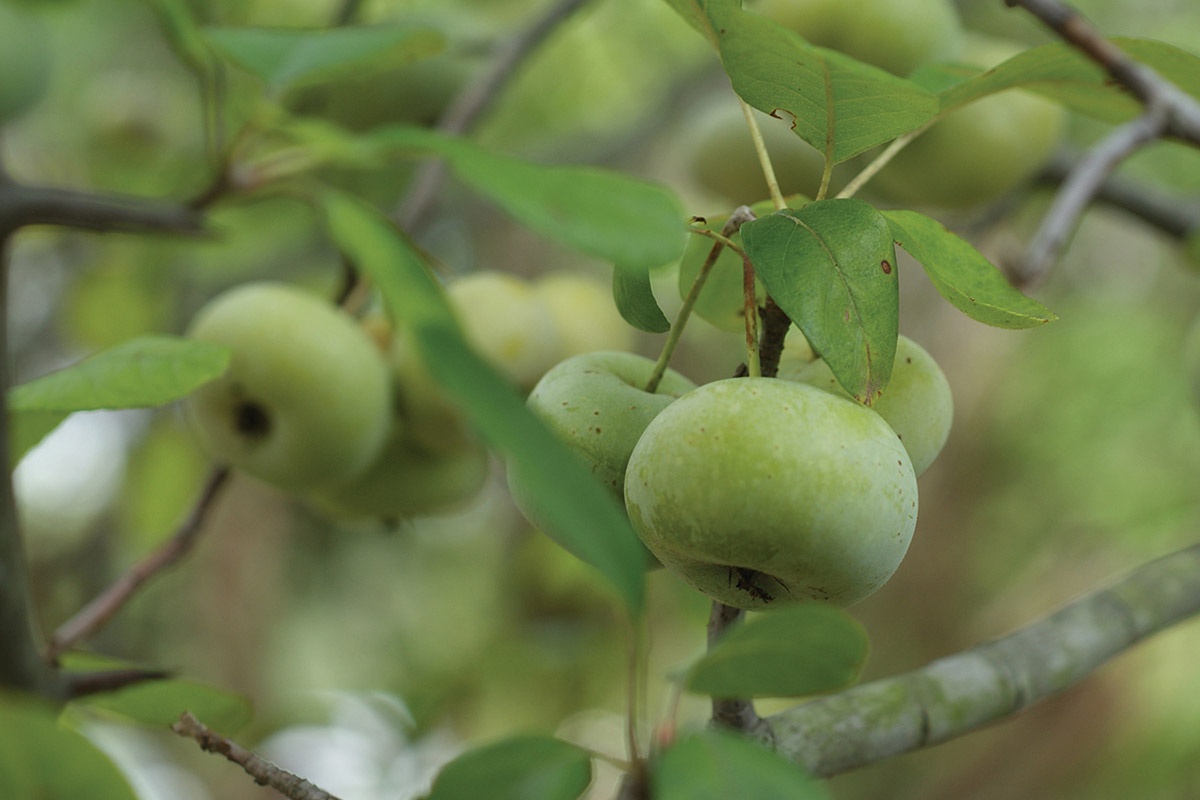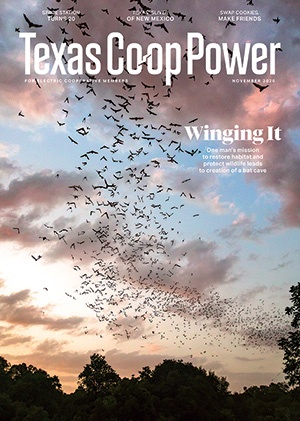Jeffery Swierc thinks of his late mother whenever he’s tending her 1940s pressure cooker filled with cherry-sized Texas crab apples. Growing up, he’d watch her turn the mouth-puckering fruit into tasty jelly every fall. Years later he still follows the same recipe passed down to his mother, Lorrane Swierc, by his grandmother and great-grandmother.
“We used to help Mother pick crab apples from two big trees on our ranch, but they rotted and died more than 15 years ago,” recalls Jeffery Swierc, who lives with his brother, Zachary, on property they inherited in northeastern Kendall County, which is served by Pedernales Electric Cooperative.
When their great-grandfather Emil Kuebel bought the original 1,280-acre ranch in 1883, Texas crab apples—also called Blanco crab apples—thrived in Kendall, Kerr, Blanco and Gillespie counties. Their abundance inspired such local names in southwestern Blanco County as Crabapple Road, Crabapple Creek and Crabapple School. In Gillespie County, German settlers established the community of Crabapple along a different Crabapple Creek and built their own Crabapple School, which still stands on Lower Crabapple Road north of Fredericksburg.
Native only to the Edwards Plateau, the thorny and thickly branched Texas crab apple forms dense thickets from underground roots and can reach a height of 15 feet. In April they bear fragrant pink or white flowers that produce hard, yellow-green fruit.
For 20 years David Winningham, a Bandera Electric Cooperative member, has germinated and sold Texas crab apples at his Natives of Texas nursery midway between Medina and Kerrville. “Crab apples make a great accent tree because of their thick foliage,” he says. “In the spring they’re covered with flowers and in the fall with fruit.”
Wilson Blackburn, a Pedernales EC member who lives on the Kendall County family farm where he grew up, remembers when Texas crab apples were common. “Then screwworms were eradicated in the 1960s,” he says, referring to the parasite that decimated cattle and reduced deer populations from the 1930s into the 1950s. “So as white-tailed deer increased, crab apples began to die out.”
Deer still get blamed for the shrinking number of crab apples in the Hill Country. “Seedlings don’t have a chance because deer come along and browse them,” says Robert Edmonson, a biologist with the Texas A&M Forest Service in Johnson City.
Both wild and cultivated crab apples stand little chance of surviving without protection. “I recommend placing cages at least 4 feet tall around trees to keep them from being browsed and deer rubbing the trunks,” says Edmonson, a Pedernales EC member. “These cages can serve a dual purpose in that any seed that falls inside the area will be protected from browsing.”
Years ago on the Swierc ranch, an uncle fenced off the family’s last crab apple motte. The enclosure, constructed of steel wire mesh and T-bar stakes, guards more than 20 shrubby trees. A few put on fruit but not enough to make jelly. So Jeffery Swierc replenishes his crab apple supply from trees on a neighbor’s ranch.
“When the apples are ripe, we put tarps under the branches and shake the trees,” he explains. “That’s the easiest way to collect the crab apples. You can’t climb the trees because they’re too thorny.”
Swierc boils the apples for half an hour on the stove. Using a wooden pestle, he presses the juice from the soft fruit through a vintage metal ricer, a cone-shaped sieve designed for mashing potatoes. “A gallon of fruit, which makes four dozen half-pint jars, calls for 7 cups of juice and 9 cups of sugar. I also add a little red food coloring, like Mother always did.”
Starting in the late ’70s, Lorrane Swierc faithfully made and donated crab apple jelly to her church’s fall bazaar in Blanco. The jars, labeled with her name and “Wild Crabapple Jelly,” never failed to sell out. “I helped Mother make it for the last time in October 2005,” Jeffery Swierc says. “She was 86 years old. The following January, she passed.”
In her honor he continued the tradition of donating crab apple jelly to the church’s annual fundraisers. Sadly, the bazaars were canceled for good in 2019. Though he misses the event, Swierc plans to continue jarring his jelly, labeled under his name, to give to family and friends.
“Whenever I drive by our Blanco crab apples, I always think how lucky I am to have a part of my family’s legacy,” he says. “We’re going to continue to preserve and take care of the trees for the next generation.”
The Blanco yard of writer Sheryl Smith-Rodgers hosts a robust Blanco crab apple bought in 2013 from David Winningham.


